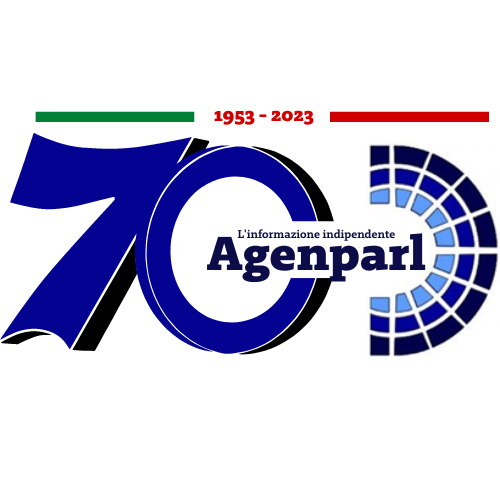 (AGENPARL) - Roma, 25 Settembre 2025
(AGENPARL) - Roma, 25 Settembre 2025(AGENPARL) – Thu 25 September 2025 https://whitney.us13.list-manage.com/track/click?u=387f59a72ae7b64ccae37d5c9&id=84332c32b7&e=59415c6e7e
** WHITNEY MUSEUM CELEBRATES A CENTURY OF ALEXANDER CALDER’S ICONIC CIRCUS WITH A DEDICATED EXHIBITION
————————————————————
Opening on October 18, High Wire: Calder’s Circus at 100 marks the hundredth anniversary of the artist’s most formative work of art and is the Whitney’s first exhibition focused on Calder’s Circus since moving to its current downtown location.
New York, NY, September 25, 2025 — The Whitney Museum of American Art’s upcoming exhibition High Wire: Calder’s Circus at 100 (https://whitney.us13.list-manage.com/track/click?u=387f59a72ae7b64ccae37d5c9&id=fc48f0d052&e=59415c6e7e), which opens on October 18, celebrates the centennial of one of the most cherished and storied works in the Whitney’s collection, Alexander Calder’s magnificent Calder’s Circus (1926–31). With over 100 wire sculptures and objects, Calder’s Circus highlights the themes of movement, balance, suspense, and ephemerality that would later define the artist’s signature mobiles. High Wire is the Whitney’s first exhibition dedicated to Calder’s Circus since moving to 99 Gansevoort and commemorates the artist’s innovation and the enduring impact this work has had on twentieth-century art.
While living as a young American artist in Paris in 1926, Calder began to build his Circus using everyday materials and found objects, creating a cast of characters that he would set in motion and narrate as a multi-act performance. Calder staged these presentations in informal settings, often for friends and artist peers. Designed to be portable, Calder’s Circus evolved over time as he continued to perform the work in Europe and America for decades. The exhibition brings together the iconic Calder’s Circus alongside wire sculptures, drawings, paintings, early abstractions, archival materials, and film to offer a view into the techniques and innovations that would define his career. Featured in the show are works from the Whitney’s collection, along with select loans from the Calder Foundation, New York.
“In Calder’s Circus, we find the essence of Calder’s brilliance: an artistic spectacle that is modest in scale but contains so much drama and humanity. He imagined and animated everyday materials—bits of fabric, cork, found wood, rubber tubes, and perhaps most importantly, wire—in a project that is at once performance, sculpture, and theater, a precursor to much of what we think of as experimental art today,” said Jennie Goldstein, the Whitney’s recently named Marion Boulton “Kippy” Stroud Curator of the Collection. “We’re thrilled for the opportunity to present this work in all its splendor, which we hope will inspire new audiences, young and old, to experience Calder’s innovation,” added Roxanne Smith, Jennifer Rubio Assistant Curator of the Collection.
“Few works have been as important to the Whitney as Calder’s Circus, a work that has captivated artists and audiences for decades,” said Kim Conaty, Nancy and Steve Crown Family Chief Curator at the Whitney. “We look forward to celebrating its milestone anniversary by offering new perspectives on this foundational work, highlighting Calder’s material innovations and radical performativity by placing it alongside the artist’s developments in drawing and painting, abstraction and wire sculpture.”
High Wire: Calder’s Circus is on view October 18–March 2025 at the Whitney Museum. The exhibition is organized by Jennie Goldstein, the inaugural Marion Boulton “Kippy” Stroud Curator of the Collection (https://whitney.us13.list-manage.com/track/click?u=387f59a72ae7b64ccae37d5c9&id=c2532d7f61&e=59415c6e7e), and Roxanne Smith, Jennifer Rubio Assistant Curator of the Collection.
Exhibition Overview – High Wire: Calder’s Circus at 100
High Wire: Calder’s Circus at 100 celebrates the centennial of one of Alexander Calder’s most iconic works and one of the most beloved in the Whitney’s collection, Calder’s Circus (https://whitney.us13.list-manage.com/track/click?u=387f59a72ae7b64ccae37d5c9&id=477c9208d2&e=59415c6e7e) (1926–31). This exhibition brings together over 100 objects from this installation, along with more than twenty related works, including wire sculptures, drawings, paintings, early abstractions, archival materials, and film.
In 1926, Calder began constructing his miniature multi-act spectacle while living in Paris, using commonplace materials—wire, fabric, cork, wood, string, and found objects—to create a cast of acrobats, animals, and other circus performers, including clowns, a sword swallower, and a ringmaster. The figures were brought to life through performances that Calder staged for audiences of artists and friends on both sides of the Atlantic, among them Marcel Duchamp, Joan Miró, Piet Mondrian, and Isamu Noguchi. These dynamic performances were set to music, complete with lighting and narration by Calder, and could last up to two hours—representing a radical new form of performance art. Over time, the number of figures, props, and tools expanded to fill five suitcases. Calder used them to transport not only the performers, but also the instruments, phonographic records, and repair materials––caps for the cap pistols, strings, fabric, sewing kits, pliers, and wires––making the performance fully
portable and true to its theatrical ephemerality.
A touchstone for Calder’s artistic development, Calder’s Circus reveals his early fascination with movement, balance, suspense, and ephemerality—concepts that would shape his pioneering invention of the mobile and define his sculptural practice in the decades that followed. This exhibition situates the Circus within Calder’s experimental engagement with this popular form, drawing connections between its energetic interplay and his later abstract works. To tell the broader story of Calder’s Circus, the exhibition includes a range of related materials that illuminate the work’s evolution and performance history, along with a 1961 film on view in the galleries. Calder collaborated with filmmaker Carlos Vilardebó to capture the artist’s final full performance of the Circus, more than thirty years after the work’s inception. Staged in his studio in Saché, France, Calder acted as ringmaster to bring the figures to life while his wife, Louisa, provided music on a gramophone. Also on view are wire
sculptures Calder created of circus subjects during the 1920s, in which he transcribes in wire the volume and essence of the body in motion, and his ink drawings of circus performers from 1931–32, which translate his sculptural wire language onto paper. The exhibition also features a display of Calder’s first standing mobiles and stabiles, the non-objective sculptures for which he is best known, marking an important turning point in his work directly following the Circus. These early abstract constructions reveal how the dynamics of chance, motion, and action inherent to the Circus would manifest throughout the rest of his career. The objects on view are accompanied by archival materials and performance ephemera, including photographs and handmade invitations, and the original suitcases, tools, and sound recordings from the Circus, which together offer an intimate look at the artist’s process and the performative, kinetic ingenuity that defined his early practice.
The Whitney holds a special relationship with Calder and his legacy. Calder’s Circus entered the Museum’s collection in 1983 following a major public acquisition campaign. Launched in 1982, the campaign drew support from institutions and individuals across the country, enabling the Museum to acquire the work, which has been a highlight of its holdings ever since. This successful effort ensured Calder’s Circus remained in New York City in a public museum, preserving the artist’s beloved work for future generations. The Whitney is the largest public repository of Calder’s work and hosted his major retrospective in 1976.
Organized to commemorate one hundred years since the inception of Calder’s Circus, this exhibition offers a rare opportunity to experience the full scope of a work that continues to enchant audiences and illuminate the foundations of Calder’s visionary practice.
About the Artist
Alexander Calder (b. 1898, Philadelphia, Pennsylvania–d. 1976, New York City), whose illustrious career spanned much of the twentieth century, is the most acclaimed and influential sculptor of our time. Born in a family of celebrated, though more classically trained artists, Calder utilized his innovative genius to profoundly change the course of modern art. He began in the 1920s by developing a new method of sculpting: by bending and twisting wire, he essentially “drew” three-dimensional figures in space. He is renowned for the invention of the mobile, whose suspended, abstract elements move and balance in changing harmony. From the 1950s onward, Calder increasingly devoted himself to making outdoor sculpture on a grand scale from bolted steel plate. Today, these stately titans grace public plazas in cities throughout the world.
Exhibition Tickets
Visitors can purchase timed tickets for High Wire: Calder’s Circus at 100, opening October 18, 2025. More ticketing information will be available on the Museum’s website (https://whitney.us13.list-manage.com/track/click?u=387f59a72ae7b64ccae37d5c9&id=9c73d0de84&e=59415c6e7e) .
Early Press Visits
Free Public Programs
A series of free virtual and in-person programs is offered in conjunction with High Wire: Calder’s Circus at 100. More information about these programs and how to register will be available on the Museum’s website (https://whitney.us13.list-manage.com/track/click?u=387f59a72ae7b64ccae37d5c9&id=ca424cd84b&e=59415c6e7e) as details are confirmed.
** PRESS CONTACT
————————————————————
For press materials and image requests, please visit our press site at whitney.org/press or contact:
Meghan Ferrucci, Senior Publicist
Whitney Museum of American Art
(212) 671-8346
Whitney Press Office
whitney.org/press
(212) 570-3633
** EXHIBITION SUPPORT
————————————————————
High Wire: Calder’s Circus at 100 is sponsored by
Major support for High Wire: Calder’s Circus at 100 is provided by the Jon and Mary Shirley Foundation, Stephanie March and Dan Benton, and Anne-Cecilie Engell Speyer.
Significant support is provided by Jill and Darius Bikoff, and Nancy and Fred Poses.
Generous support is provided by Laurie M. Tisch Illumination Fund.
Additional support is provided by The Lipman Family Foundation and an anonymous donor.
** ABOUT THE WHITNEY
————————————————————
The Whitney Museum of American Art, founded in 1930 by the artist and philanthropist Gertrude Vanderbilt Whitney (1875–1942), houses the foremost collection of American art from the twentieth and twenty-first centuries. Mrs. Whitney, an early and ardent supporter of modern American art, nurtured groundbreaking artists when audiences were still largely preoccupied with the Old Masters. From her vision arose the Whitney Museum of American Art, which has been championing the most innovative art of the United States for ninety years. The core of the Whitney’s mission is to collect, preserve, interpret, and exhibit American art of our time and serve a wide variety of audiences in celebration of the complexity and diversity of art and culture in the United States. Through this mission and a steadfast commitment to artists, the Whitney has long been a powerful force in support of modern and contemporary art and continues to help define what is innovative and influential in American art today.
Whitney Museum Land Acknowledgment
The Whitney is located in Lenapehoking, the ancestral homeland of the Lenape. The name Manhattan comes from their word Mannahatta, meaning “island of many hills.” The Museum’s current site is close to land that was a Lenape fishing and planting site called Sapponckanikan (“tobacco field”). The Whitney acknowledges the displacement of this region’s original inhabitants and the Lenape diaspora that exists today.
As a museum of American art in a city with vital and diverse communities of Indigenous people, the Whitney recognizes the historical exclusion of Indigenous artists from its collection and program. The Museum is committed to addressing these erasures and honoring the perspectives of Indigenous artists and communities as we work for a more equitable future. To read more about the Museum’s Land Acknowledgment, visit the Museum’s website (https://whitney.us13.list-manage.com/track/click?u=387f59a72ae7b64ccae37d5c9&id=5338b83a44&e=59415c6e7e) .
** VISITOR INFORMATION
————————————————————
The Whitney Museum of American Art is located at 99 Gansevoort Street between Washington and West Streets, New York City. Public hours are Monday, Wednesday, and Thursday, 10:30 am–6 pm; Friday, 10:30 am–10 pm; and Saturday and Sunday, 10:30 am–6 pm. Closed Tuesday. Visitors eighteen years and under and Whitney members: FREE. The Museum offers FREE admission and special programming for visitors of all ages every Friday evening from 5–10 pm and on the second Sunday of every month.
============================================================
Whitney Museum of American Art
99 Gansevoort Street New York, NY 10014
** whitney.org (https://whitney.us13.list-manage.com/track/click?u=387f59a72ae7b64ccae37d5c9&id=08bbf050fa&e=59415c6e7e)
** (https://whitney.us13.list-manage.com/track/click?u=387f59a72ae7b64ccae37d5c9&id=a21f093a10&e=59415c6e7e)
** (https://whitney.us13.list-manage.com/track/click?u=387f59a72ae7b64ccae37d5c9&id=0e91ac2d9e&e=59415c6e7e)
** (https://whitney.us13.list-manage.com/track/click?u=387f59a72ae7b64ccae37d5c9&id=332f4b789f&e=59415c6e7e)
** (https://whitney.us13.list-manage.com/track/click?u=387f59a72ae7b64ccae37d5c9&id=29b2d3508f&e=59415c6e7e)
** (https://whitney.us13.list-manage.com/track/click?u=387f59a72ae7b64ccae37d5c9&id=e6c1c0ca30&e=59415c6e7e)
** (https://whitney.us13.list-manage.com/track/click?u=387f59a72ae7b64ccae37d5c9&id=4e065d92df&e=59415c6e7e)
** (https://whitney.us13.list-manage.com/track/click?u=387f59a72ae7b64ccae37d5c9&id=420efda91d&e=59415c6e7e)
Discover the Whitney’s audio guides and accessible content on ** Bloomberg Connects (https://whitney.us13.list-manage.com/track/click?u=387f59a72ae7b64ccae37d5c9&id=b0cbb197b6&e=59415c6e7e)
** Update your preferences (https://wmaa-email-preferences.mailchimpsites.com/manage/preferences?u=387f59a72ae7b64ccae37d5c9&id=2d1244a32b&e=59415c6e7e&c=6bde7dd072)
to change the types of emails you receive from the Whitney.
** Forward (https://us13.forward-to-friend.com/forward?u=387f59a72ae7b64ccae37d5c9&id=6bde7dd072&e=59415c6e7e)
this email to a friend.
** Unsubscribe (https://whitney.us13.list-manage.com/unsubscribe?u=387f59a72ae7b64ccae37d5c9&id=2d1244a32b&t=b&e=59415c6e7e&c=6bde7dd072)
from all Whitney emails.
Image credits:
York. Photograph by Sheldan C. Collins
